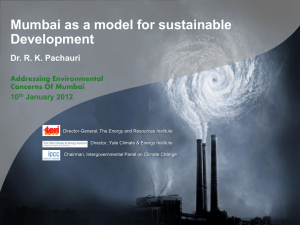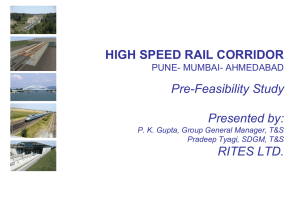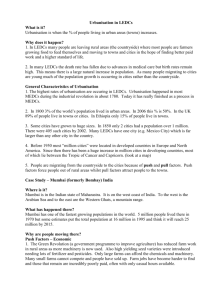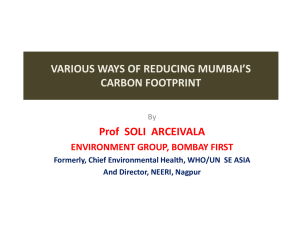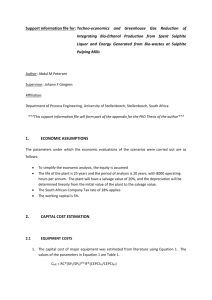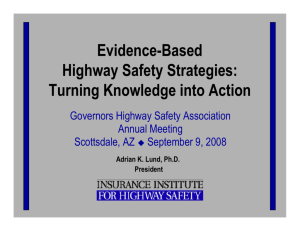Presentation - The 21st Century Indian City
advertisement
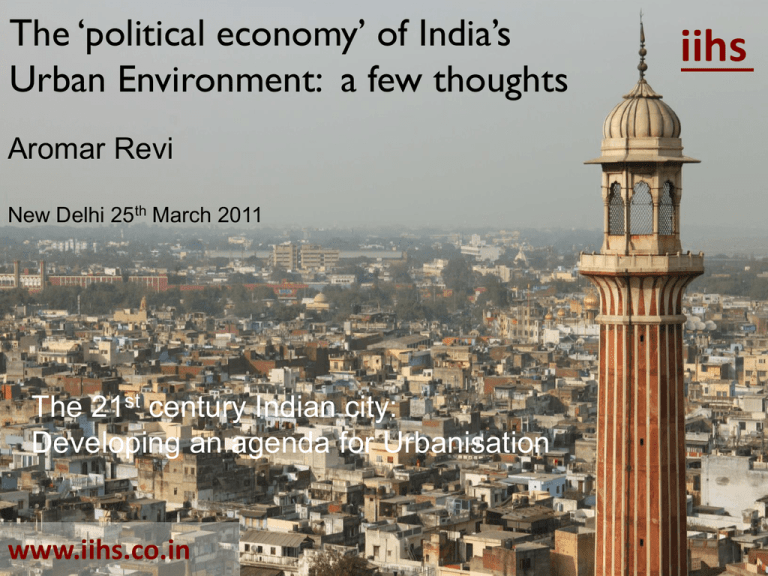
The ‘political economy’ of India’s Urban Environment: a few thoughts Aromar Revi New Delhi 25th March 2011 The 21st century Indian city: Developing an agenda for Urbanisation www.iihs.co.in iihs Mumbai: minimum city… Slums in the City Mumbai: a cross-section of Slums Bharat Nagar and other slums, Raoli Junction Ekvira Nagar, Salt pan land Near Airport Ganesh Murty Nagar Mumbai’s Slum Services: Water Supply Bharat Nagar Dharavi Shanti Nagar Chikhalwadi Ambedkar Nagar Mumbai’s Slum Services: Solid Waste Garbage dumping place, Andhra Association Garbage Bin, Near Khotwadi Unhygienic surroundings, Anna Nagar Clean Street, Dadabhai Chawl Mumbai’s formal & informal Land Price differentials Average developed land and property value by ward, 2005 120000 Colaba Average developed land value (FSI-1) Rs. per.sq.m Value (Rs.per.sqm) 100000 Average property value Rs. per.sq.m 80000 Land value of studied slums Rs. per.sq.m Bandra Peddar Road 60000 Ghatkopar 40000 Mulund 20000 T R PN M KW H W S G FS E C A 0 Ward Name Mumbai’s (imputed) land market value estimated in 2005 at ~ Rs. 560,000 crores. Distortions in this market primary factor in the huge (55%+) city slum population Outcome Mumbai: the slum capital of the world • 7 million+ people living in ‘slums’ • Dysfunctional land & housing markets • Declining quality of public services & security • Tardy transformation of landuse & economic functions • Declining quality of governance • Ecological footprints expanding across the subcontinent • Steady decline in resource-use efficiency • Increasing polarisation of wealth this is clearly unsustainable … Open Defecation: 0.5 million people per day in Mumbai RECOMMENDED CONCEPT OPTION: MMR 2031 “City Of Islands” Comparative long-range Urbanisation trends (1950-2050) Urbanisation trends: India, China & the USA (1950-2050) Urbanisation rate (% of total population) 100% 90% 80% 70% 60% 50% 40% 30% 20% 10% 0% 1950 World 1960 1970 China 1980 India 1990 Years 2000 2010 2020 2030 2040 2050 USA UN World Urbanisation Prospects, 2007 India: an dramatic opportunity for balanced RUrban development Global Health Risk forecast by risk factor (2005-2060) Source: Hughes et. al., 2011, Improving Global Health, Forecasting for the next 50 Years The Dynamics of Indian Urbanisation (1951-2031) 1951 Tibet W. Pakistan Nepal E. India Population Size (millions) < 0.1 0.1 – 0.5 0.5 - 1 1-5 >5 Source: Census of India, 1971- 2001 UN, 2007 IIHS analysis, 2009-10 Pakistan Population (in millions) 2011 Delhi (16.9) 800 700 600 500 400 300 200 100 0 1951 1961 1971 1981 1991 2001 2011 2021 2031 Urban Population Growth Ahmadabad (5.7) Kolkata (15.5) Mumbai (20) 1-5 >5 Source: Census of India, 1971- 2001 UN, 2007 IIHS analysis, 2009-10 Pune (5.0) Bangalore (7.2) Chennai (7.5) Urban Settlements Population Size (millions) < 0.1 0.1 – 0.5 0.5 - 1 Hyderabad (6.7) 800 700 600 500 400 300 200 100 0 1951 1961 1971 1981 1991 2001 2011 2021 2031 Large Urban Settlement Growth Population (in millions) 2031 Delhi (24.4) 800 700 600 500 400 300 200 100 0 1951 1961 1971 1981 1991 2001 2011 2021 2031 Urban Population Growth Kanpur (5.1) Ahmadabad (8.5) Kolkata (22.3) Surat (6.3) Mumbai (28.6) 1-5 >5 Source: Census of India, 1971-2001 UN, 2007 IIHS analysis, 2009-10 Pune (7.4) Bangalore (10.6) Chennai (11.1) Urban Settlements Population Size (millions) < 0.1 0.1 – 0.5 0.5 - 1 Hyderabad (9.9) 800 700 600 500 400 300 200 100 0 1951 1961 1971 1981 1991 2001 2011 2021 2031 Large Urban Settlement Growth The Growth of India’s Urban Economy (1991-2031) Growth of India's Urban Economy (1991-2031) Rs. Trillion / lakh crores 300 250 200 150 100 Rs. 1450 lakh crores 50 Rs 735 lakh crores 1991 2001 2011 Time (years) GDP (current prices) Urban GDP 2021 2031 Indian Cities & the global 21st century Sustainability transition The Challenge of the 21st century Sustainability Transition Present consumption requires ~2.0 worlds 21st century Population growth needs 1.5+ worlds Available only One World Ending poverty at present throughput ~2.0 worlds This transition will be played out in Indian & Chinese cities 20th century pre-emption of ‘ecological space’ (1900-2004) ∆ Order of Magnitude + Cumulative Carbon emissions over the 20th century potentially pre-empts ecological & hence human development ‘space’ in the global South Can Services-sector led growth enable a Sustainability Transition? Services-sector growth led to very different outcomes in the US, Japan & Germany. China has chosen a conventional manufacturing-export led strategy unlike India Ecological Footprint vs. HDI (1975) ‘Sustainable Development ’ The ‘holy grail’ of national Sustainable Development a HDI of ~ 0.9 & Ecological Footprint of 1 global Ha/per capita The Sustainability transition will be fought & won in cities Early 21st century ‘tunnelling through’ will be fought and won in Asian and ‘emerging economy’ urban areas and around new metabolisms, economies and sufficiencies Future History - Sustainability Transitions: 2005 ‘Sustainable Development’ Can China traverse the environmental Kuznets curve; Germany & USA converge without serious Human Development decline India ‘tunnel through’; or will there be serious international ‘resource’ conflict? A new form of urbanisation? India’s Settlement structure matched to deliver Climate adaptation & mitigation co-benefits Revi, 2010 ~ 7,800 urban areas and ~ 0.55 million rural settlements in 20011 – the opportunity for decentralised production and consumption systems and economic structure Catalysing five national outcomes by the 2030s ‘Inclusive’ Economic Growth Reduced Poverty and Inequality Social Transformation Environmental Sustainability Unified & Robust Polity Who really ‘manages’ Urban India? Top Management • MPs & MLAs • Higher Judiciary • IAS & IPS • CXOs (top 500 corporates) • NGO leadership Total % educated & trained in urban practice Middle Management • Senior Municipal officials • Senior Engineers • Urban Planners Total % educated & trained in urban practice 5,300 650 8,200 ~ 5,000 ~ 1,750 20,900 < 5% ~ 4,000 ~ 8,000 ~ 2,000 ~ 14,000 < 20%

